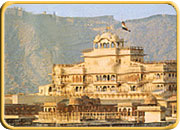Jaipur
Jaipur Forts & Palaces
City Palace
 The
City Palace Complex gives you an idea about the farsightedness of the founder
of Jaipur Sawai Jai Singh. He left behind a legacy of some of the most imposing
and magnificent architecture, art and craft structure in the city. Sawai Jai
Singh built its many buildings but some of some of the structures were also
built by later rulers and some of them are even dated in the in the twentieth
century too. The palace is a blend of Mughal and Rajasthani architecture and
the royal family still lives in a part of the palace.
The
City Palace Complex gives you an idea about the farsightedness of the founder
of Jaipur Sawai Jai Singh. He left behind a legacy of some of the most imposing
and magnificent architecture, art and craft structure in the city. Sawai Jai
Singh built its many buildings but some of some of the structures were also
built by later rulers and some of them are even dated in the in the twentieth
century too. The palace is a blend of Mughal and Rajasthani architecture and
the royal family still lives in a part of the palace. On entering the complex and before the palace proper lies the Mubarak Mahal, the palace of welcome or reception. Sawai Madho Singh built the palace in the nineteenth century. It was used as a reception centre for the visiting personage. The building now forms the Maharaja Sawai Man Singh II Museum and on display here are a wide array of royal costumes, some very exquisite and precious Pashmina (Kashmiri) Shawls, Benaras silk saris, Sanganeri prints and folk embroidery. An unusual display is that of voluminous clothes worn by Maharaja Sawai Madho Singh I (ruled 1750-68).
The Maharani's Palace, the palace of the Queen paradoxically puts a display of the Rajput weaponry. The inestimable collections of weapons date back to even 15th century and are in a remarkable state of preservation. Remarkable amongst them is scissor-action dagger. This deadly weapon when thrust in bodies the handles were release to spread the blades. The dagger was then withdrawn tearing limb from limb of the body of the hapless victim into certain fatality. Other exhibits include protective chain armours, pistols, jewelled and ivory handled swords, a belt sword, small and assorted cannons, guns, poison tipped blades and gun powder pouches. The frescos on the ceiling are amazing and well preserved.
The art gallery is located in the Diwan-I-Aam, which literally mean the Hall of public audience. The exhibits here included some very precious and ancient handwritten original manuscripts of Hindu scriptures. Particularly intriguing in miniature copies of Bhagwat Gita made in this manner so that it can be concealed out of sight of Emperor Aurangzeb’s onslaught on Hindu scriptures. Some very delicate miniature paintings in Rajasthani, Mughal and Persian schools on various themes including the Ramayana are very engrossing displays. Visitors must also take a good at preserved painted ceilings. Also on display are elephant saddles called “haudha”.
Between the armoury museum and the art gallery is the Diwan-I-Khas meaning hall of private or selective audience. This is a marble paved pavilion and puts on display the world largest sterling silver object two gigantic silver vessels. These vessels were made for Maharaja Sawai Madho Singh II, who took in along with him filled with water from River Ganga for drinking. As a devout Hindu the Maharaja did not wish to risk polluted English waters. The ceiling also has large chandeliers, which are mostly protected by dust covers and opened only of festive occasions. The Guinness Book of Records accounts it has the biggest silver objects in the world. Select a holiday with us